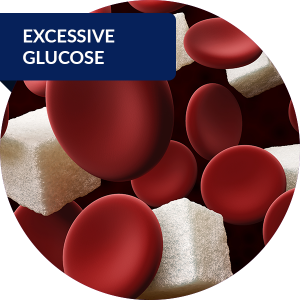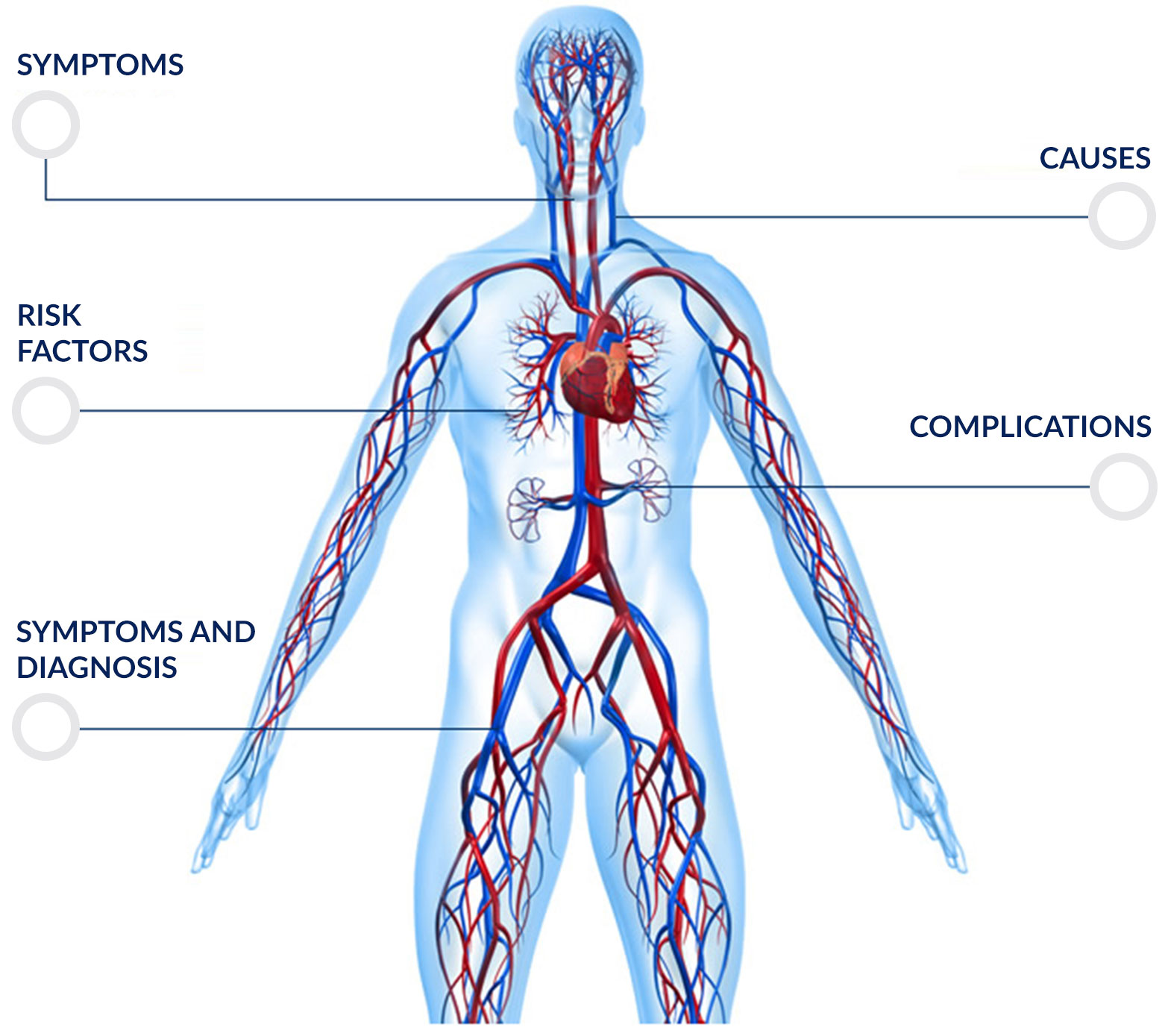
Diabetes mellitus is a chronic disease characterized by a high concentration of glucose (sugar) in the blood, caused by changes in metabolism.
Glucose is of vital importance for the body, because it is an essential source of energy for cells forming muscles and other tissues. Glucose is the main source of energy for the brain.
However, excessive blood glucose (hyperglycemia), can cause serious health issues.
Chronic conditions connected to diabetes include:
- type 1 diabetes usually appears during childhood or adolescence;
- type 2 diabetes is the most common; it is more frequent among adults, although it is becoming increasingly common among children due to an increased obesity rate. Type 2 diabetes can be prevented by acting on risk factors such as familiarity and lifestyle.
The following conditions can potentially be reversed:
- dysglycemia: when fasting or two hours after meals, blood sugar levels are higher than normal, but not high enough to classify this condition as diabetes.
- Gestational diabetes appears during pregnancy, and it generally disappears after childbirth.
Select to learn more

Symptoms
Symptoms vary depending on how much your blood sugar is elevated. Some people, especially those with prediabetes or type 2 diabetes, may not experience symptoms initially. In type 1 diabetes, symptoms tend to appear quickly and be more severe. Some of the signs and symptoms of type 1 and type 2 diabetes include:
- increased thirst
- frequent urination
- extreme hunger
- unexplained weight loss
- presence of ketones in urine
- fatigue
- blurred vision
- slow-healing sores
- arterial hypertension
- frequent infections
Type 1 diabetes usually appears during childhood or adolescence. Type 2 diabetes is the most common; it is more frequent among adults, although it is becoming increasingly common among children due to higher obesity rates. Type 2 diabetes can be prevented by identifying the risk factors, such as a genetic predisposition, and by making changes to your lifestyle.
Causes
To understand diabetes, we must first understand how glucose is normally processed in the body.
Insulin is a hormone produced in the pancreas, a gland located behind and below the stomach.
The pancreas releases insulin into the bloodstream. The insulin circulates, enabling sugar to enter your cells and be used through the cells’ metabolism. Insulin lowers the amount of sugar in your bloodstream, reducing blood sugar levels (sugar concentration in the blood). As blood sugar levels drop, so does the secretion of insulin from the pancreas, because it is no longer necessary.
Glucose, an essential source of energy for the heart and brain, comes from two main sources: food and the liver. The livers stores glucose and releases it when it is required.
Causes of type 1 diabetes
In type 1 diabetes the immune system, which normally fights harmful bacteria or viruses, attacks and destroys insulin-producing cells in the pancreas. This causes the body to produce little or no insulin; thus, instead of being transported to the cells, sugar accumulates in the bloodstream. Type 1 is thought to be caused by a combination of genetic susceptibility and environmental factors, though the exact role that these factors may be playing is still unclear.
Causes of prediabetes and type 2 diabetes
In prediabetes, which can lead to type 2 diabetes, and in type 2 diabetes, cells become resistant to the action of insulin, and the pancreas is unable to make enough insulin to overcome this resistance. Instead of moving into the cells where it’s needed for energy, sugar builds up in the bloodstream. Causes are still uncertain, even though – like for type 1 diabetes – genetic and environmental factors are thought to play a part in the development of this condition. Obesity is strongly linked to the development of type 2 diabetes, but not everyone suffering with type 2 diabetes is overweight.
Causes of gestational diabetes
During pregnancy, the placenta produces hormones that can make cells more resistant to insulin. The placenta develops mainly during the second and third trimester; this causes an increase in the secretion of these hormones, making it even harder for insulin to do its job.
Normally, your pancreas responds by producing enough extra insulin in order to overcome the hormones’ increased resistance. In gestational diabetes, this does not happen; therefore, cells receive less sugar, and there is a higher concentration of sugar in the blood.
Risk factors
Risk factors for diabetes depend on the type of diabetes.
Risk factors for type 1 diabetes
Although the exact cause of type 1 diabetes is unknown, genetic factors may play a key role. The risk of developing type 1 diabetes increases if you have a parent or a sibling with type 1 diabetes. Environmental factors, such as exposure to a viral illness, likely play some role in type 1 diabetes. Other factors that may increase your risk include:
- The presence of damaged cells in the immune system: sometimes family members of people with type 1 diabetes are tested for the presence of diabetes autoantibodies; if you have these autoantibodies, you have an increased risk of developing type 1 diabetes; however, not everyone who has these autoantibodies will develop type 1 diabetes.
- Diet: a number of diet-related factors have been linked to an increased risk of type 1 diabetes, such as a low vitamin D intake, early exposure to cow milk, and exposure to grains before the age of 4 months. However, none of these has been proven to be a direct cause of diabetes.
- Ethnicity: type 1 diabetes is more common in with a white background.
- Geography: certain countries, such as Finland and Sweden, have higher rates of type 1 diabetes.
Risk factors for prediabetes and type 2 diabetes
Researchers don’t fully understand why some people develop prediabetes and type 2 diabetes and others don’t. It’s clear, however, that certain factors increase the risk, including:
- Weight. The more fatty tissue you have, the more resistant your cells become to insulin.
- Lack of exercise. People who are less physically active are at greater risk. Physical activity helps you control your weight, uses up glucose as energy and makes cells more sensitive to insulin. Exercise can help reduce the risk of type 2 diabetes.
- Family history. Your risk increases if a parent or sibling has type 2 diabetes.
- Ethnicity. Although it’s unclear why, people of a certain ethnicity, including black people, Hispanics, American Indians and Asian-Americans, are at higher risk.
- Age. Risk increases with age. This may be because people tend to exercise less, lose muscle mass and gain weight as they age. However, type 2 diabetes is also increasing among children, adolescents and young adults.
- Pregnancy. Developing gestational diabetes, increases your risk of developing prediabetes and type 2 diabetes.
- Polycystic ovary syndrome. Polycystic ovary syndrome, a common condition characterized by irregular menstrual periods, acne and obesity, increases the risk of diabetes.
- Hypertension. Having blood pressure over 140/90 mm Hg is linked to an increased risk of type 2 diabetes.
- Dyslipidemia. If you have low levels of high-density lipoprotein (HDL), or “good,” cholesterol, your risk of type 2 diabetes is higher. A level of HDL below 35 mg/dL is considered low.
- High levels of triglycerides. If triglycerides increase over 250 mg / dL, the risk of diabetes increases.
Risk factors for gestational diabetes
Any pregnant woman can develop gestational diabetes, but some women are at greater risk than are others. Other risk factors are:
- Age. Women aged over 35 are at greater risk.
- Family history or personal history. Risk increases in cases of prediabetes, or if you have a family member, such as a parent or a sibling, who suffers with type 2 diabetes; it also increases if you have had gestational diabetes during a previous pregnancy, if you gave birth to a very large baby, or had an inexplicable still birth.
- Weight. Being overweight before pregnancy increases your risk.
- Ethnicity. For reasons that aren’t clear, women who are black, Hispanic, American Indian or Asian are more likely to develop gestational diabetes.
Complications
Long-term complications of diabetes develop gradually. The longer you have diabetes, and the less controlled your blood sugar, the higher the risk of complications. Eventually, diabetes complications may be disabling or even life-threatening. Possible complications include:
- Cardiovascular disease. Diabetes dramatically increases the risk of various cardiovascular problems, including coronary artery disease with chest pain (angina), heart attack, stroke and narrowing of arteries (atherosclerosis).
- Nerve problems (neuropathy). Excess sugar can injure the walls of the tiny blood vessels (capillaries) that nourish the nerves, particularly in the legs. This can cause tingling, numbness, burning or pain that usually begins at the tips of the toes or fingers and gradually spreads upward. Damage to the nerves can also cause problems such as nausea, vomit, diarrhoea or constipation. In men, it can cause erectile dysfunction.
- Kidney damage (nephropathy). The kidneys contain millions of tiny blood vessel (glomeruli) that filter the blood. Diabetes can damage this delicate filtering system. Severe damage can lead to kidney failure or irreversible end-stage kidney disease, which may require dialysis or a kidney transplant. Rates of severe kidney disease have dropped significantly in recent years, probably due to improvements in diabetes control therapies.
- Retinopathy. Diabetes can damage the blood vessels of the retina (diabetic retinopathy), potentially leading to changes in your vision and even to blindness. Diabetes also increases the risk of other serious vision conditions, such as cataracts and glaucoma.
- Diabetic foot. The damage caused by diabetes to nerves and blood circulation in the feet can cause complications such as small cuts and blisters which, if left untreated, can turn into severe ulcers. This can lead to the amputation of part of all of the limb.
- Damage to the skin and mouth. Diabetes may leave you more susceptible to skin problems, including bacterial and fungal infections. Gum infections can be more frequent and more severe, particularly if hygiene is poor.
- Osteoporosis. Diabetes can cause lower bone mineral density, increasing the risk of osteoporosis.
- Alzheimer’s. Type 2 diabetes can increase the risk of Alzheimer’s disease. Causes are uncertain; one theory is that cardiovascular problems caused by diabetes may contribute to dementia by reducing the blood flow to the brain.
- Tumours. People with diabetes are at greater risk of developing certain types of cancer. Causes are uncertain. This could be due to factors that increase the risk of type 2 diabetes, which may also increase the risk of cancer.
Symptoms and diagnosis
Symptoms of type 1 diabetes often appear suddenly and can be easily linked to the disease, which is therefore diagnosed quickly and more easily. Conversely, symptoms of other types of diabetes and prediabetes come on more gradually or may not be evident for a long time. The American Diabetes Association (ADA) has recommended that the following people be screened for diabetes:
- Anyone with a body mass index higher than 25, regardless of age, who has additional risk factors, such as high blood pressure, a sedentary lifestyle, a history of polycystic ovary syndrome, a history of gestational diabetes, high levels of cholesterol, a history of heart disease, and having a close relative with diabetes.
- Anyone older than age 45 is advised to receive an initial blood sugar screening, and then, if the results are normal, to be screened every three years after that.
Tests for type 1 and type 2 diabetes
Glycated haemoglobin (HbA1C) test. This blood test indicates your average blood sugar level for the past two to three months. It measures the percentage of blood sugar attached to haemoglobin, the oxygen-carrying protein in red blood cells. The higher your blood sugar levels, the more haemoglobin will have sugar attached. A HbA1C level of 6.5 percent or higher on two separate tests may indicate that you have diabetes. If the HbA1C test results aren’t consistent, the test isn’t available, or you have certain conditions that can make the HbA1C test inaccurate, such as if you’re pregnant or have an uncommon form of haemoglobin (known as a haemoglobin variant), your doctor may use the following tests to diagnose diabetes:
- Random blood sugar test. This is a simple blood sugar level test. You do not need to fast, which means that this test can be performed regardless of what you ate or drank. A random blood sugar level of 200 milligrams per decilitre (mg/dL), 11.1 millimoles per litre (mmol/L), or higher when fasting suggests diabetes.
- Fasting blood sugar test. A blood sample will be taken after an overnight fast. A fasting blood sugar level from 100 to 125 mg/dL (5.6 to 6.9 mmol/L) is considered prediabetes. Levels of 126 mg/dL (7 mmol/L) or higher on two separate tests may suggest that you have diabetes.
- If type 1 diabetes is suspected, your urine will be tested to look for the presence of ketones, a byproduct produced when muscle and fat tissue are used to produce energy when the body doesn’t have enough insulin to use the available glucose.
- Occasionally, peptide C levels may be tested, to measure the pancreas’ ability to release insulin. Levels of peptide C are usually low in people with type 1 diabetes, but they can be normal or high in people with type 2 diabetes.
- Oral glucose tolerance test. A blood sample is taken and analyzed after fasting for eight hours. You then drink a sugary liquid, and blood sugar levels are tested again after two hours. A blood sugar level less than 140 mg/dL (7.8 mmol/L) is normal. A blood sugar level between 140 and 199 mg/dL (7.8 mmol/L and 11.0 mmol/L) indicates prediabetes.




